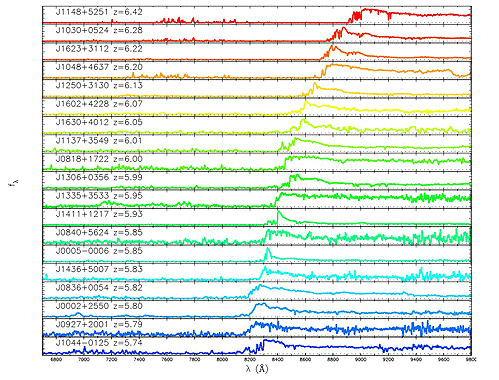
In the multimedia tutorial and in the first supporting page, we concentrated on the Doppler effect in sound and also used water waves as an example. For electromagnetic radiation – light, radio, gamma rays etc, the same principles apply and we can often use the equations derived there for the frequency f ' observed when a source emits a frequency f:

where v is the velocity of the wave, vs is the velocity of the source, vo that of the observer, and where vs and vo are taken as positive for approaching and negative for receding.
For electromagnetic radiation, v = c is the speed of light, which is about 3 x 108 m.s−1. Consequently, the proportional changes in frequency and wavelength are very small for ordinary speeds vs and vo. However, frequency is one of the quantities that can be measured with very high precision, so the radar guns used by highway patrols (picture at right) are commonly capable of measuring frequency shifts of less than 1 part in 108, and so can accurately measure the speed of vehicles travelling at a few tens of m.s−1.
The animations above should be treated as cartoons. The one on the left shows a wave in a hypothetical, two dimensional universe that is spherical in three-space. As that universe expands, the length of the wave increases. The animation at right shows a few galaxies in the same unrealistic universe. The further apart they are, the longer the time light has taken to reach us, and so the more time the waves have had to expand, along with the space through which they have travelled. If you have been wondering 'Why are all the galaxies going away from us? Is it something we said?', then the cartoon on the right answers your question. There is nothing special about our position: as space expands, everything in the universe recedes from everything else. If you inflate a balloon, then from any point on the balloon it appears that all other points are receding at a rate that increases with current distance of separation. The spectra below, data kindly provided by Xiaohui Fan, show the same feature in a set of spectra from quasars with z values from 5.74 (bottom) to 6.42 (top). For all of these spectra, the wavelengths have been stretched by a factor of around six over the time it took their light to reach us. They are so distant that the time one calculates for the light to to reach us depends on which cosmological model one uses in the calculation. However, in all models it is of the order of 10 billion years. |
 |
Relativistic red shiftsThere are two further causes of red shift in astronomical objects. First, objects that are moving with respect to an observer exhibit time dilation due to relative motion. Time passes more slowly on those objects: their clocks tick more slowly and their atoms emit radiation with lower frequency.Consider for example an object whose motion is at right angles to the line separating us. It is neither approaching us nor receding from us. So there is no Doppler shift (in the ordinary sense of the word). It does, however, have relative motion and so exhibits time dilation. So it shows a relativistic red shift. Another red shift comes from general relativity: Einstein's theory of gravitation. Objects at low gravitational potential exhibit time dilation, too. Near the surface of a star, the gravitational potential is lower than ours so, for massive stars with intense gravitational fields, there is a gravitational red shift. The light from the sun is gravitationally red-shifted (gravitational potential at the surface of the sun is lower than at the surface of the earth). |
No comments:
Post a Comment